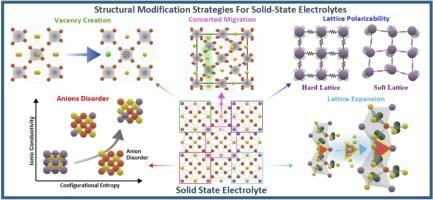当前位置:
X-MOL 学术
›
Nano Energy
›
论文详情
Our official English website, www.x-mol.net, welcomes your
feedback! (Note: you will need to create a separate account there.)
Structural engineering developments in sulfide solid-state electrolytes for lithium and sodium solid-state batteries
Nano Energy ( IF 16.8 ) Pub Date : 2024-11-07 , DOI: 10.1016/j.nanoen.2024.110447 Mohammad Sufiyan Nafis, Zhiming Liang, Sehee Lee, Chunmei Ban
Nano Energy ( IF 16.8 ) Pub Date : 2024-11-07 , DOI: 10.1016/j.nanoen.2024.110447 Mohammad Sufiyan Nafis, Zhiming Liang, Sehee Lee, Chunmei Ban

|
Solid-state batteries (SSBs), especially those derived from lithium and sodium, show great promise as the next generation of energy storage devices due to their remarkable energy density, compact electrode architecture, nonflammability, and the use of metallic anodes. The solid-state electrolytes (SSEs), a significant part of SSBs, are essential to their functionality. A family of SSEs known as sulfide-based has been extensively studied for many years as a potential SSE for sodium and lithium SSBs. It offers excellent ionic conductivity, favorable mechanical properties, and ease of manufacturing. Notwithstanding its advantages, it also presents several problems, which require careful consideration for it to be successfully commercialized. This review summarizes the recent advancements in SSEs for lithium and sodium SSBs. It explores how structural engineering strategies impact the electrochemical properties of argyrodites SSEs for lithium SSBs and Na3 PS4 -based SSEs for sodium SSBs. The review provides comprehensive information on successful structural engineering approaches, such as introducing vacancies, mobile ions stuffing, and doping, for both lithium and sodium SSEs. It also discusses the air stability and electrochemical stability against electrodes, offering insights for designing and synthesizing next-generation SSEs that can lead to more durable and efficient energy storage systems.
中文翻译:

锂和钠固态电池用硫化物固态电解质的结构工程发展
固态电池 (SSB),尤其是那些由锂和钠衍生的电池,由于其卓越的能量密度、紧凑的电极结构、不易燃性和金属阳极的使用,作为下一代储能设备显示出巨大的前景。固态电解质 (SSE) 是 SSB 的重要组成部分,对其功能至关重要。多年来,被称为硫化物基的 SSE 家族作为钠和锂 SSB 的潜在 SSE 已被广泛研究。它具有出色的离子导电性、良好的机械性能和易于制造。尽管具有优点,但它也存在一些问题,需要仔细考虑才能成功商业化。本文总结了锂和钠 SSB 的 SSE 的最新进展。它探讨了结构工程策略如何影响用于锂 SSB 的 argyrodite SSE 和用于钠 SSB 的基于 Na3PS4 的 SSE 的电化学性能。该综述提供了有关成功的结构工程方法的全面信息,例如为锂和钠 SSE 引入空位、移动离子填充和掺杂。它还讨论了空气稳定性和对电极的电化学稳定性,为设计和合成下一代 SISE 提供了见解,从而可以带来更耐用、更高效的储能系统。
更新日期:2024-11-07
中文翻译:

锂和钠固态电池用硫化物固态电解质的结构工程发展
固态电池 (SSB),尤其是那些由锂和钠衍生的电池,由于其卓越的能量密度、紧凑的电极结构、不易燃性和金属阳极的使用,作为下一代储能设备显示出巨大的前景。固态电解质 (SSE) 是 SSB 的重要组成部分,对其功能至关重要。多年来,被称为硫化物基的 SSE 家族作为钠和锂 SSB 的潜在 SSE 已被广泛研究。它具有出色的离子导电性、良好的机械性能和易于制造。尽管具有优点,但它也存在一些问题,需要仔细考虑才能成功商业化。本文总结了锂和钠 SSB 的 SSE 的最新进展。它探讨了结构工程策略如何影响用于锂 SSB 的 argyrodite SSE 和用于钠 SSB 的基于 Na3PS4 的 SSE 的电化学性能。该综述提供了有关成功的结构工程方法的全面信息,例如为锂和钠 SSE 引入空位、移动离子填充和掺杂。它还讨论了空气稳定性和对电极的电化学稳定性,为设计和合成下一代 SISE 提供了见解,从而可以带来更耐用、更高效的储能系统。


















































 京公网安备 11010802027423号
京公网安备 11010802027423号